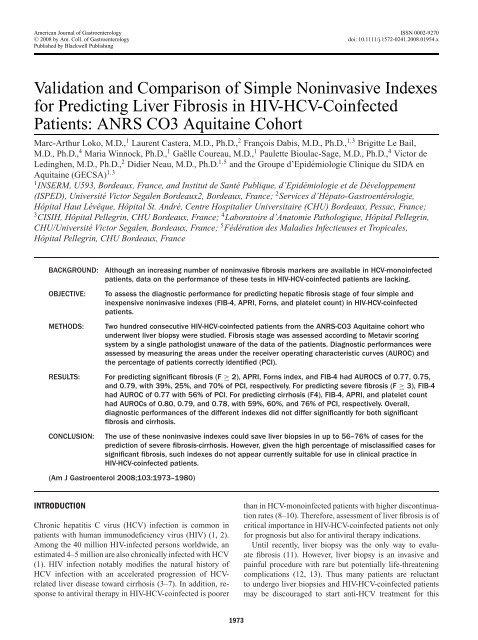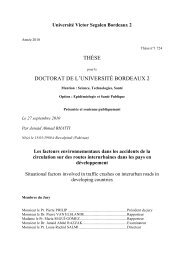Create successful ePaper yourself
Turn your PDF publications into a flip-book with our unique Google optimized e-Paper software.
American Journal of Gastroenterology ISSN 0002-9270<br />
C○ 2008 by Am. Coll. of Gastroenterology<br />
doi: 10.1111/j.1572-0241.2008.01954.x<br />
Published by Blackwell Publishing<br />
Validation and Comparison of Simp<strong>le</strong> Noninvasive Indexes<br />
for Predicting Liver Fibrosis in HIV-HCV-Coinfected<br />
Patients: ANRS CO3 Aquitaine Cohort<br />
Marc-Arthur Loko, M.D., 1 Laurent Castera, M.D., Ph.D., 2 François Dabis, M.D., Ph.D., 1,3 Brigitte Le Bail,<br />
M.D., Ph.D., 4 Maria Winnock, Ph.D., 1 Gaël<strong>le</strong> Coureau, M.D., 1 Pau<strong>le</strong>tte Bioulac-Sage, M.D., Ph.D., 4 Victor de<br />
Ledinghen, M.D., Ph.D., 2 Didier Neau, M.D., Ph.D. 1,5 and the Groupe d’Epidémiologie Clinique du SIDA en<br />
Aquitaine (GECSA) 1,3<br />
1 INSERM, U593, Bordeaux, France, and Institut de Santé Publique, d’Epidémiologie et de Développement<br />
(ISPED), Université Victor Sega<strong>le</strong>n Bordeaux2, Bordeaux, France; 2 Services d’Hépato-Gastroentérologie,<br />
Hôpital Haut Lévêque, Hôpital St. André, Centre Hospitalier Universitaire (CHU) Bordeaux, Pessac, France;<br />
3 CISIH, Hôpital Pel<strong>le</strong>grin, CHU Bordeaux, France; 4 Laboratoire d’Anatomie Pathologique, Hôpital Pel<strong>le</strong>grin,<br />
CHU/Université Victor Sega<strong>le</strong>n, Bordeaux, France; 5 Fédération des Maladies Infectieuses et Tropica<strong>le</strong>s,<br />
Hôpital Pel<strong>le</strong>grin, CHU Bordeaux, France<br />
BACKGROUND:<br />
OBJECTIVE:<br />
METHODS:<br />
Although an increasing number of noninvasive fibrosis markers are availab<strong>le</strong> in HCV-monoinfected<br />
patients, data on the performance of these tests in HIV-HCV-coinfected patients are lacking.<br />
To assess the diagnostic performance for predicting hepatic fibrosis stage of four simp<strong>le</strong> and<br />
inexpensive noninvasive indexes (FIB-4, APRI, Forns, and plate<strong>le</strong>t count) in HIV-HCV-coinfected<br />
patients.<br />
Two hundred consecutive HIV-HCV-coinfected patients from the ANRS-CO3 Aquitaine cohort who<br />
underwent liver biopsy were studied. Fibrosis stage was assessed according to Metavir scoring<br />
system by a sing<strong>le</strong> pathologist unaware of the data of the patients. Diagnostic performances were<br />
assessed by measuring the areas under the receiver operating characteristic curves (AUROC) and<br />
the percentage of patients correctly identified (PCI).<br />
RESULTS: For predicting significant fibrosis (F ≥ 2), APRI, Forns index, and FIB-4 had AUROCS of 0.77, 0.75,<br />
and 0.79, with 39%, 25%, and 70% of PCI, respectively. For predicting severe fibrosis (F ≥ 3), FIB-4<br />
had AUROC of 0.77 with 56% of PCI. For predicting cirrhosis (F4), FIB-4, APRI, and plate<strong>le</strong>t count<br />
had AUROCs of 0.80, 0.79, and 0.78, with 59%, 60%, and 76% of PCI, respectively. Overall,<br />
diagnostic performances of the different indexes did not differ significantly for both significant<br />
fibrosis and cirrhosis.<br />
CONCLUSION:<br />
The use of these noninvasive indexes could save liver biopsies in up to 56–76% of cases for the<br />
prediction of severe fibrosis-cirrhosis. However, given the high percentage of misclassified cases for<br />
significant fibrosis, such indexes do not appear currently suitab<strong>le</strong> for use in clinical practice in<br />
HIV-HCV-coinfected patients.<br />
(Am J Gastroenterol 2008;103:1973–1980)<br />
INTRODUCTION<br />
Chronic hepatitis C virus (HCV) infection is common in<br />
patients with human immunodeficiency virus (HIV) (1, 2).<br />
Among the 40 million HIV-infected persons worldwide, an<br />
estimated 4–5 million are also chronically infected with HCV<br />
(1). HIV infection notably modifies the natural history of<br />
HCV infection with an acce<strong>le</strong>rated progression of HCVrelated<br />
liver disease toward cirrhosis (3–7). In addition, response<br />
to antiviral therapy in HIV-HCV-coinfected is poorer<br />
than in HCV-monoinfected patients with higher discontinuation<br />
rates (8–10). Therefore, assessment of liver fibrosis is of<br />
critical importance in HIV-HCV-coinfected patients not only<br />
for prognosis but also for antiviral therapy indications.<br />
Until recently, liver biopsy was the only way to evaluate<br />
fibrosis (11). However, liver biopsy is an invasive and<br />
painful procedure with rare but potentially life-threatening<br />
complications (12, 13). Thus many patients are reluctant<br />
to undergo liver biopsies and HIV-HCV-coinfected patients<br />
may be discouraged to start anti-HCV treatment for this<br />
1973
















